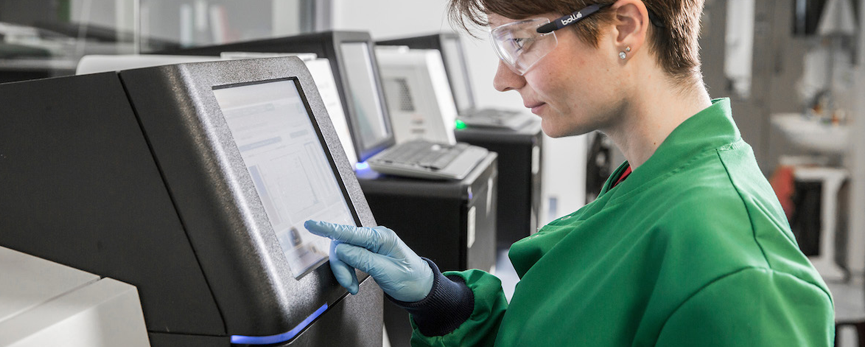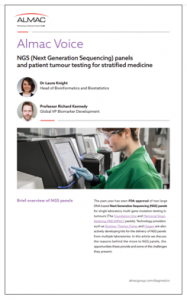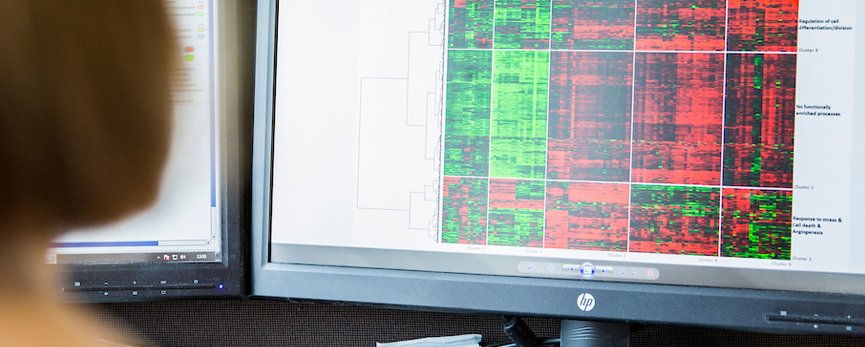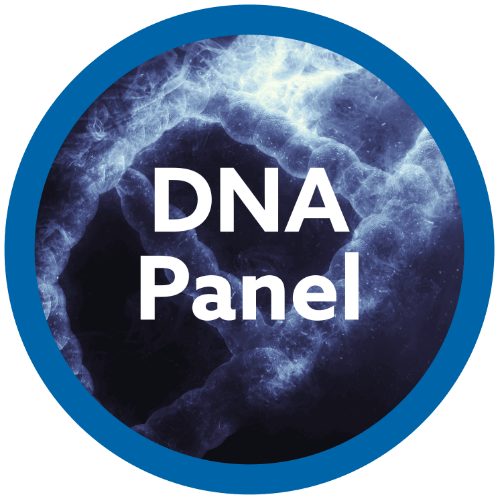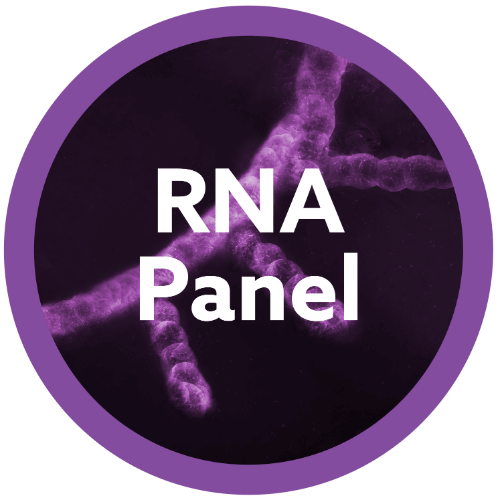NGS (Next Generation Sequencing) panels and patient tumour testing for stratified medicine
 Dr Laura Knight
Dr Laura Knight
Head of Bioinformatics and Biostatistics, Almac Diagnostic Services
 Professor Richard Kennedy
Professor Richard Kennedy
Global VP Biomarker Development, Almac Diagnostic Services
The past year has seen FDA approval of two large DNA-based Next Generation Sequencing (NGS) panels for single laboratory multi-gene mutation testing in tumours (The Foundation One and Memorial Sloan Kettering MSK-IMPACT panels). Technology providers such as Illumina, Thermo Fisher and Qiagen are also actively developing kits for the delivery of NGS panels from multiple laboratories. In this article we discuss the reasons behind the move to NGS panels, the opportunities these provide and some of the challenges they present.
Why NGS panels?
In the case of solid tumours, clinicians often have limited amounts of material to provide for molecular biomarker testing. Lung cancer, for example, may be diagnosed with a trans-bronchial biopsy which provides as little as a 5mm diameter sample of mixed tumour and normal cells and often yields less than 100ng of DNA and RNA.
Traditional approaches to DNA or RNA analysis such as PCR-based methodologies can use substantial amounts of material in order to give a single assay result. This may leave the patient and their clinician in the position of receiving a negative predictive biomarker result and no additional tissue to test. This is particularly an issue where an actionable mutation is relatively rare such as the ROS1 gene rearrangement which predicts response to crizotinib in non-small cell lung cancer (approximately 2% of cancers).
In addition, clinical trials are increasingly following “umbrella” designs where multiple drugs are offered depending on the results of more than one assay. It is therefore often impossible to run assays that use large amounts of material in these studies. It is also logistically difficult to send samples to more than one assay vendor, especially as there may be interdependencies on the results (i.e. a second assay is only considered if the first assay is negative).
NGS panels, targeted panels and exome-wide RNA panels
NGS panels offer a solution to these issues. Modern targeted DNA panels can provide cost effective gene aberration data in several hundred genes simultaneously with as little as 20ng of DNA input. Whole exome sequencing (WES) panels can extend this coverage to over 20,000 genes but are less practical for regular clinical use due to cost and through-put limitations with current diagnostic platforms. Furthermore, non-coding DNA regions may be important in predicting response to certain drugs and these would not be covered by WES.
Targeted panels, restricted to genes and mutation “hotspots” of interest such as the FDA-approved Oncomine Dx panel from ThermoFisher or the TruSight Tumor 170 platform from Illumina, can be more cost effective to analytically validate and run in a diagnostic lab. Targeted platforms can also be designed to sequence non-coding regions that are mutated in disease.
Exome-wide RNA panels are also now available and can be used to deliver what could be considered an infinite number of gene expression based assays, providing they are based on measuring coding transcripts. Current platforms can use as little as 20ng mRNA although formalin-fixed paraffin embedded based samples may require larger inputs due to mRNA degradation.
Potential issues
The move to panel based NGS strategies has presented some challenges, particularly in the regulatory space. A major concern is the level of validation required to allow clinical decisions to be made safely. In the case of clinical trials these panels fall under CLIA/CLEP legislation in the US and CE marking in the EU.
Typically an approach is taken where the lab demonstrates that the panel can properly detect aberration class types such as deletions, insertions, single nucleotide variations and copy number variations through a representative number of each rather than validation of every gene (which would be extremely challenging). Labs need to be able to demonstrate adequate analytical validation including precision (repeatability and reproducibility), sensitivity (minimum allele frequency detected) and accuracy (through comparison of results to an alternative orthogonal technology such as digital droplet PCR or Sanger Sequencing). Due to the large amounts of data measured, and the varying approaches to data filtering, there will always be some analytical error in these studies, especially in measurement of mutations at low (1% or less) allele frequency.
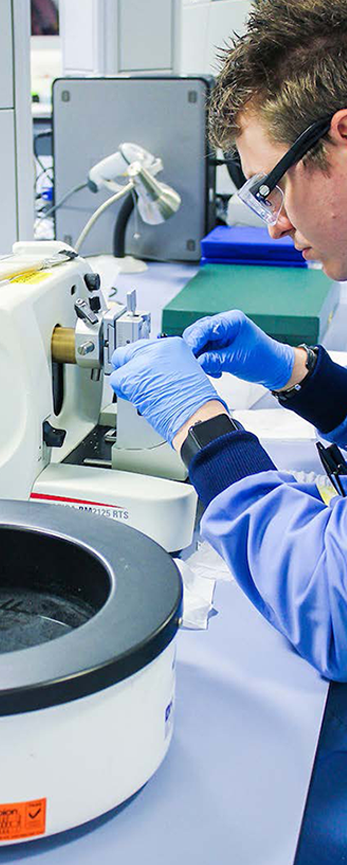 In addition, Formalin Fixed Paraffin Embedded (FFPE) tissue can represent a challenge due to the introduction of formalin-related artefacts. In our experience, as many as 20-30% of the gene aberrations identified in unfiltered data from low quality material, are FFPE artefacts. Of concern, some of these could mistakenly be considered pathogenic and in the worst case lead to the wrong treatment being recommended. It is therefore important that a fresh tissue/FFPE comparative dataset is run on new technologies to ensure the bioinformatic pipeline has appropriate filtering for these artefacts.
In addition, Formalin Fixed Paraffin Embedded (FFPE) tissue can represent a challenge due to the introduction of formalin-related artefacts. In our experience, as many as 20-30% of the gene aberrations identified in unfiltered data from low quality material, are FFPE artefacts. Of concern, some of these could mistakenly be considered pathogenic and in the worst case lead to the wrong treatment being recommended. It is therefore important that a fresh tissue/FFPE comparative dataset is run on new technologies to ensure the bioinformatic pipeline has appropriate filtering for these artefacts.
In the case of somatic variant calling, the gold standard is to run a matched normal reference (typically white cells from blood) alongside the tumour sample, such that germline variants and common polymorphisms can be filtered out. However, this increases the cost of NGS profiling as it requires two samples to be run per patient. Somatic variant calling from a single sample is also possible, but it requires using databases (such as dbsnp, sift, polyphen, COSMIC etc.) to filter out synonymous variants. Often the use of databases is not enough and can leave behind some variants that would have been filtered out with the use of the normal reference. Novel bioinformatics algorithms have also been proposed to distinguish somatic vs germline alterations, for example the SGZ (somatic-germlinezygosity) method that is employed in the Foundation One assay from Foundation Medicine.
DNA panels
A potential issue for targeted DNA panels as opposed to WES is that they may have inadequate chromosomal coverage to make an accurate measurement of copy number variations (CNV) and ploidy. This can be particularly challenging where a tumour contains significant amounts of non-cancer material such as white cells or stroma.
In our opinion, WES, with a reference normal DNA sample from white blood cells, still represents the best methodology for CNV measurement. Similarly, WES is the platform of choice for the measurement of tumour mutation burden (TMB), the number of mutations per megabase, which may have utility in selecting patients for immune checkpoint targeted therapies. NGS panels targeted to a few hundred genes or less may not have adequate DNA coverage to provide an accurate measurement of TMB using standard counting approaches.
RNA panels
In the case of RNA based panels, mRNA can also be adversely affected by FFPE sample degradation, particularly in samples over 6 months old. These FFPE specific effects must be accounted for in the quality control steps and the measurement of unstable mRNA transcripts should be excluded from biomarker signatures. It is also important to have pre-defined control samples to run with each batch of patient samples to ensure the process is running within specification, as minor deviations from protocols can have large effects on mRNA-based assay results.
In the case of NGS panel companion diagnostics, where specific gene mutations or gene expression signatures are linked to the successful registration of a drug, the regulatory authorities expect a higher level of validation. If a pre-existing FDA-approved assay exists the diagnostic lab will need to show that the panel performs as well as the previous assay.
In the case of new assays, the lab will need to analytically and clinically validate the panel for the specific genes of interest, using clinically relevant material and suitable GMP level reagents. Other genes on the panel that have not been previously validated may also be reported to clinicians under CLIA/CLEP guidance, but these will need to be considered informative rather than being used specifically for drug selection.
In conclusion
In the case of solid tumours where material may be limited, NGS panels clearly have an advantage over older, single biomarker based technologies and are likely to dominate in the next few years.
It is important to point out, however, for more readily accessible material such as blood or saliva, material quantity is less of an issue and older molecular technologies such as PCR may still be preferable due to reduced cost and potentially increased sensitivity.
In the long term, we believe it is likely that advances in technology will allow whole exome and eventually whole genome sequencing to be used routinely in clinical practice. This will ensure the maximum achievable amount of information can be gained from small clinical samples.
Almac’s Clinical Trial Solutions
Almac Diagnostic Services has created novel panel solutions for multi-arm clinical trials – enabling clients to evaluate multiple biomarkers from one sample, whilst saving precious tissue, time and cost. For further information on our panels click on the options below:

Please contact Almac Diagnostic Services if you would like to discuss any of the points raised.
Download file

 Professor Richard Kennedy
Professor Richard Kennedy